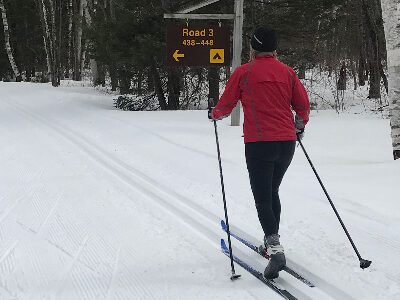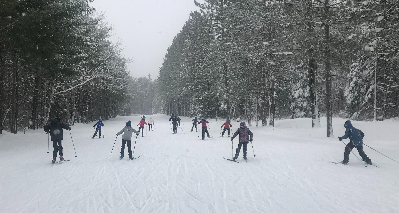We are getting into the thick of “Blue January” and many of us may be looking for ways to stave off the seasonal blues.
Now that we have some snow, participation in winter activities can be a great way accomplish this and stay fit during the winter months. A wide variety of snow sports exist so we don’t get bored; a few examples include snowshoeing, skating, and multiple varieties of skiing. But if you are growing tired of the line-ups and costs that come with activities such as downhill skiing, you may want to consider giving the skinny-ski sister sport—cross-country (xc) skiing—a try! PLUS, Arrowhead Provincial Park and Limberlost Wildlife Reserve have just recently opened their trails. (YAY! Does happy dance.)
There are many reasons why you should consider strapping on some xc skis this year.

It’s an entire body workout. Xc-skiing works the upper and lower body as well as our core with synchronized pushing and pulling movements. It works everything from your glutes, quads, and calves to your pecs, lats, triceps, and more.
It burns a lot of calories. At the recreational level, you can expect to burn ~400-600 calories/hour.
Improved cardiovascular fitness. A sustained high-level heart rate while xc-skiing allows your heart to become stronger and more efficient at supplying your body with freshly oxygenated blood. Actually, cross-country skiers are the athletes with the highest VO2 max, yes even more so than marathon runners. (Runners this makes xc-skiing great for cross training!) Overall, you can expect an increase in stamina and endurance, even across other areas of your life.
Decreased impact on hips and knees. Xc-skiing’s gliding action causes minimal impact on the feet, knees, and hips compared to running sports such as soccer, rugby, or football.
Socialize OR enjoy some solitude. Xc-skiing can be done in either large or small groups; it’s the perfect way to get in some exercise and catch up with your pals. On the other hand, maybe some silence in nature is what you crave—being outside amongst the trees and crisp air is a perfect way to enjoy some peace and quiet.
Get outside. Need I say more?
Can I get injured cross-country skiing?
Cross-country skiing has a very low injury rate when compared to downhill sports like alpine skiing and snowboarding. Generally, most injuries I see with relation to cross-country skiing are overuse injuries, which usually develop as a result of training errors like doing too much too soon or poor technique. Common injuries in elite or recreational athletes include tendinitis, muscle strains, shin splints, shoulder impingement, and compartment syndrome. Don’t fret though, there are tons of ways we can prevent injuries in xc-skiing.

Preventing injury
Dryland training (before ski season). Use this time to improve your endurance; bike, hike, run, walk, roller ski (for experienced skiers) several times a week. Include strength training for your upper and lower body as well as your core. AND don’t forget about balance training, which is often overlooked by many.
Proper equipment. Ensure that your equipment fits properly; equipment that is too small or large can lead to poor biomechanics (movement patterning) and can lead to injury. Dress appropriately, it can be cold outside but then when we get moving we heat up quickly. Wear moisture-wicking clothing layers with a waterproof exterior. If your muscles get cold, injuries are more likely to occur.
Pre-training warm-up. Cold muscles are more prone to injury so it is important to do a warm-up. Note, a warm-up can look different depending on your experience level. Nonetheless, it should include a general warm-up, dynamic stretching, and technical drills.
General warm-up should be 5-10 minutes in duration. The goal is to get blood flowing to all parts of the body. It can include a nice easy ski on flat terrain, light jog, jumping jacks, or a combination.
Dynamic stretching is to be completed directly after your general warm-up and can include movements like arm circles, leg swings, lunges, butt kicks, etc.
Technical drills are usually more cross-country specific such as double poling, single pole, or no pole drills. More elite-level skiers may include speed work in this section of their warm-up.
Technique. Proper technique decreases stress on your body and can help to prevent injuries. Beginners should consider taking lessons to learn proper body alignment and skills to help decrease injury. Even the most elite level athletes have coaches for this reason.
Arrowhead Nordic here in town has great group, small group, or private lessons to get a hang of technique; and if your kids want to partake in lessons, they may even be assigned to my class.
Taking breaks. We are at increased risk for injury when we become fatigued. It is important during the first few skis of the season to take breaks and slowly increase our time out on skis. If you are feeling tired, take a break.
Post-training cool-down. A cool-down allows our body to gradually return to its resting state. It allows any waste products that built up during exercise (e.g lactic acid) to dissipate and can reduce delayed-onset muscle soreness (otherwise known as DOMS).
Cool down by gradually reducing the intensity: slow your ski pace right down. Alternatively, once you have removed your gear walking is a great way to cool down. Similar to our warm up, 5-10 minutes should be sufficient.
Static stretching should be completed after the cool-down but before the muscles have completely cooled off. It is a stretch that is held and maintained for a length of time 30s-1min and allows for lengthening and improved flexibility in the muscles used.
Because of the full-body nature of cross-country skiing, there are many different exercises that can be helpful in terms of pre-season, pre-ski warm-up, and post-ski cool-down. Pre-season exercises may include pole walking, strengthening such as bridging, squats, tricep pull downs, rotator cuff, core and flexibility training. Pre-ski warm-up can include dynamic movements such as plyometric skaters, lunges, arm circles/swings, etc. Specific training drills may be more dependent on where your technical weakness lie or what your training is to focus on that day. Post-ski cool-down should include full-body stretching such as our calves, hip flexors, lateral hip musculature, back, and triceps to name a few.

Cross-country skiing, although sometimes difficult to master as a result of the required coordination, strength, and endurance, is a fun and active way to enjoy winter with a low incidence of injury compared to other sports. By following these prevention tips, you should have a safe and enjoyable ski season.
In addition to being a Registered Physiotherapist, Stephanie coaches at the youth and high school level of cross-country skiing and is involved on the integrated support team (as a physiotherapist) with Cross Country Ski Ontario. If you are interested in more specific programming to improve your stride, prevent or rehab from injury, I’d be happy to help you out in the clinic and/or on the trails.
Happy skiing!
For more information or to book an appointment call 705-380-3312 or visit the website. Surge Physiotherapy is located at 33 King William Street, Suite 204, in Huntsville. Office hours are flexible with evening appointments available (three times per week). Email: [email protected].

Stephanie Bourbeau is a bilingual, Registered Physiotherapist with the College of Physiotherapist of Ontario and the Canadian Physiotherapy Association who is committed to providing a hands-on, personalized approach to physiotherapy.
Stephanie, a native to the Huntsville community, developed a passion for health and wellness during her youth while competing in cross-country running, nordic skiing, and track and field. Stephanie has always had a strong caring nature and fell in love with the physiotherapy profession while volunteering at a physiotherapy clinic during high school and university.
Stephanie continued to build on her passion for health care by attending McGill University and completing her Bachelors of Science in Kinesiology. During her Masters in Health Science of Physiotherapy, completed at the University of Ottawa, she completed internships in orthopaedic clinics, hospitals, home care, and neurology centres.
[/column][column size=”1/2″]
Recent Comments